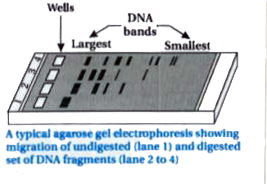Give the method for separation and isolation of DNA fragments.
Text Solution
Due to the use of restriction endonuclease, DNA results into fragments. These fragments can be separated by a technique known as gel electrophoresis.
DNA fragments are negatively charged molecules. They can be separated by forcing them to move towards the anode under an electric field through a medium/matrix. Which is a natural polymer extracted from sea weeds.
In gel electrophoresis, agarose is used as matrix.
The DNA fragments separate according to their size through sieving effect provided by the agarose gel. Hence the smaller the fragment size, the farther it moves.
The separated DNA fragments can be visualised only after staining the DNA with a compound known as ethidium bromide followed by exposure the UV radiation.
You can see bright - orange coloured bands of DNA in a ethidium bromide stained gel exposed to UV light.
The separated bands of DNA are cut out from the agarose gel and extracted from the gel piece. This step is known as elution.
The DNA fragments purified in this way are used in constructing recombinant DNA by joining them with cloning vectors.
Cloning vector : Plasmids and bacteriophages have the ability to replicate within bacterial cells independent of the control of chromosomal DNA.
Bacteriophage because of their high number per cells have very high copy numbers of their genome within the bacterial cells.
Some plasmids may have only one or two copies per cell whereas others may have 15-100 copies per cell. Their numbers can go even higher.
If we are able to link an alien piece of DNA with bacteriophage or plasmid DNA we can multiply its numbers equal to the copy number of the plasmid or bacteriophage.

|
Topper's Solved these Questions
- BIOTECHNOLOGY : PRINCIPLES AND PROCESSESBOOK - KUMAR PRAKASHANCHAPTER - BIOTECHNOLOGY : PRINCIPLES AND PROCESSESEXERCISE - SECTION - B (DIFFERENCE/SCIENTIFIC REASONS)
5 Videos
- BIOTECHNOLOGY : PRINCIPLES AND PROCESSESBOOK - KUMAR PRAKASHANCHAPTER - BIOTECHNOLOGY : PRINCIPLES AND PROCESSESEXERCISE - SECTION - C (OBJECTIVE QUESTIONS - ANSWERS)
6 Videos
- BIODIVERSITY AND CONSERVATIONBOOK - KUMAR PRAKASHANCHAPTER - BIODIVERSITY AND CONSERVATIONEXERCISE - SECTION - F (MCQs A SKED IN COMPETITIVE EXAM)
70 Videos
- BIOTECHNOLOGY AND ITS APPLICATIONSBOOK - KUMAR PRAKASHANCHAPTER - BIOTECHNOLOGY AND ITS APPLICATIONSEXERCISE - Section - F (Multiple Choice Questions (MCQs ASKED IN COMPETITIVE EXAM))
90 Videos
Similar Questions
Name and explain the techniques used in separation and isolation of DNA fragments to be used in recombinant DNA technology.
View SolutionIn the given process of separation and isolation of DNA fragments,some of the steps are missing,Complete the missing steps
A: Restriction digestion of DNA fragments
↓
B: ……………………
↓
C: Staining with ethidium bromide
↓
D: Visualisation in U.V. light
↓
E: ............
↓
F: Purification of DNA fragments.
View Solution
Knowledge Check
The technique used for separation of DNA fragment is:
AautoradiographyBgel electrophoresisCmicroinjectionDgel-filtration chromatographyDuring gel electrophoresis for separation of DNA fragment :
Asmallest fragment will not move to the farthest pointBsmallest fragment will move to the farthest pointClargest fragment will move to the farthest pointDlasrgest fragment will move to the farthest point towards anodeDuring gel electrophoresis for separation of DNA fragment:
ASmallest fragment will move to the farthest point towards cathodeBSmallest fragment will move to the farthest point towards anodeCLargest fragment will move to the farthest point towards cathodeDLagest fragment will move to the farthest point towards anode
How isolation and separation of DNA fragments is done ?
View SolutionThe technique used for separation of DNA fragment is:
View SolutionDuring gel electrophoresis for separation of DNA fragment :
View SolutionDuring gel electrophoresis for separation of DNA fragment :
View SolutionWhich instrument is used for the separation of DNA fragments
View Solution
